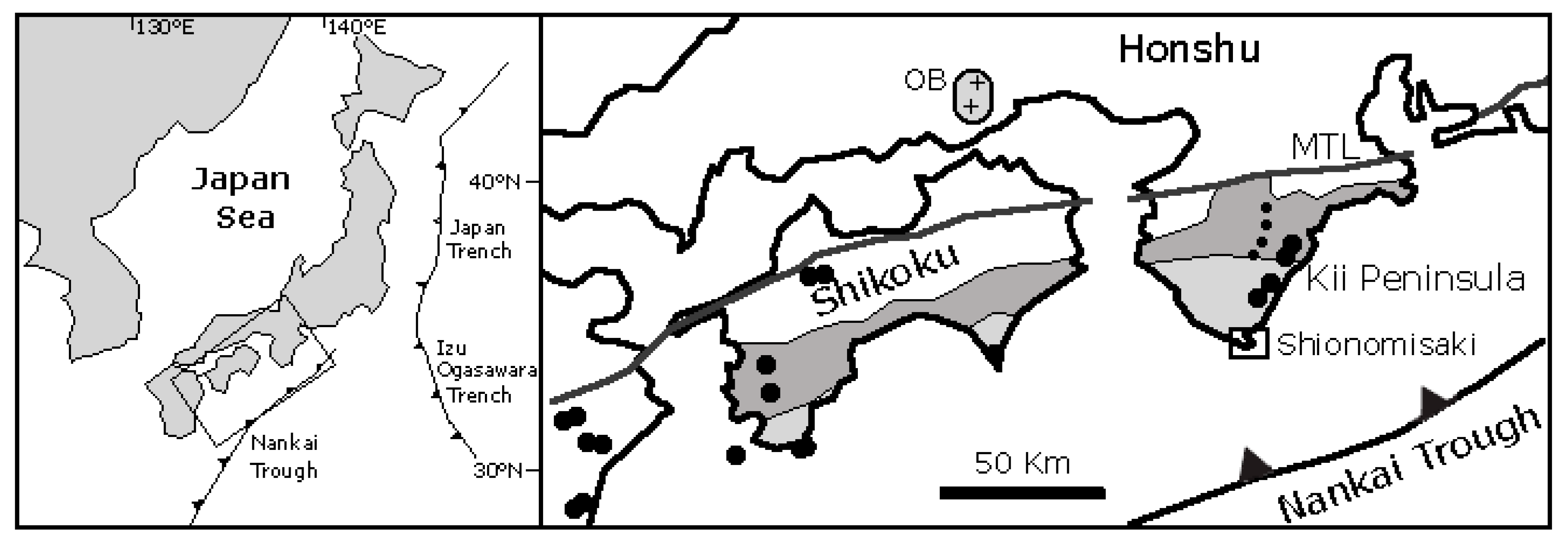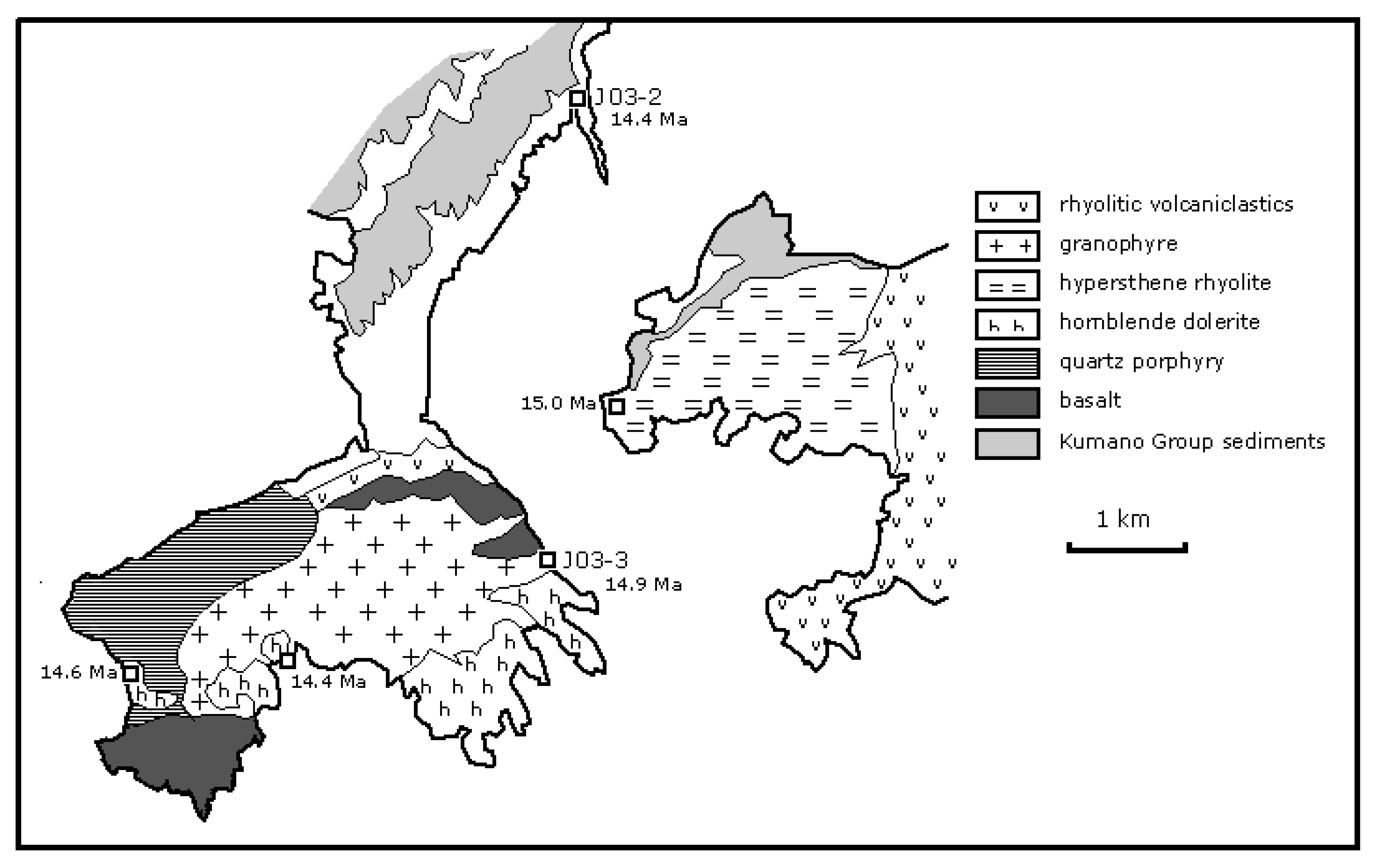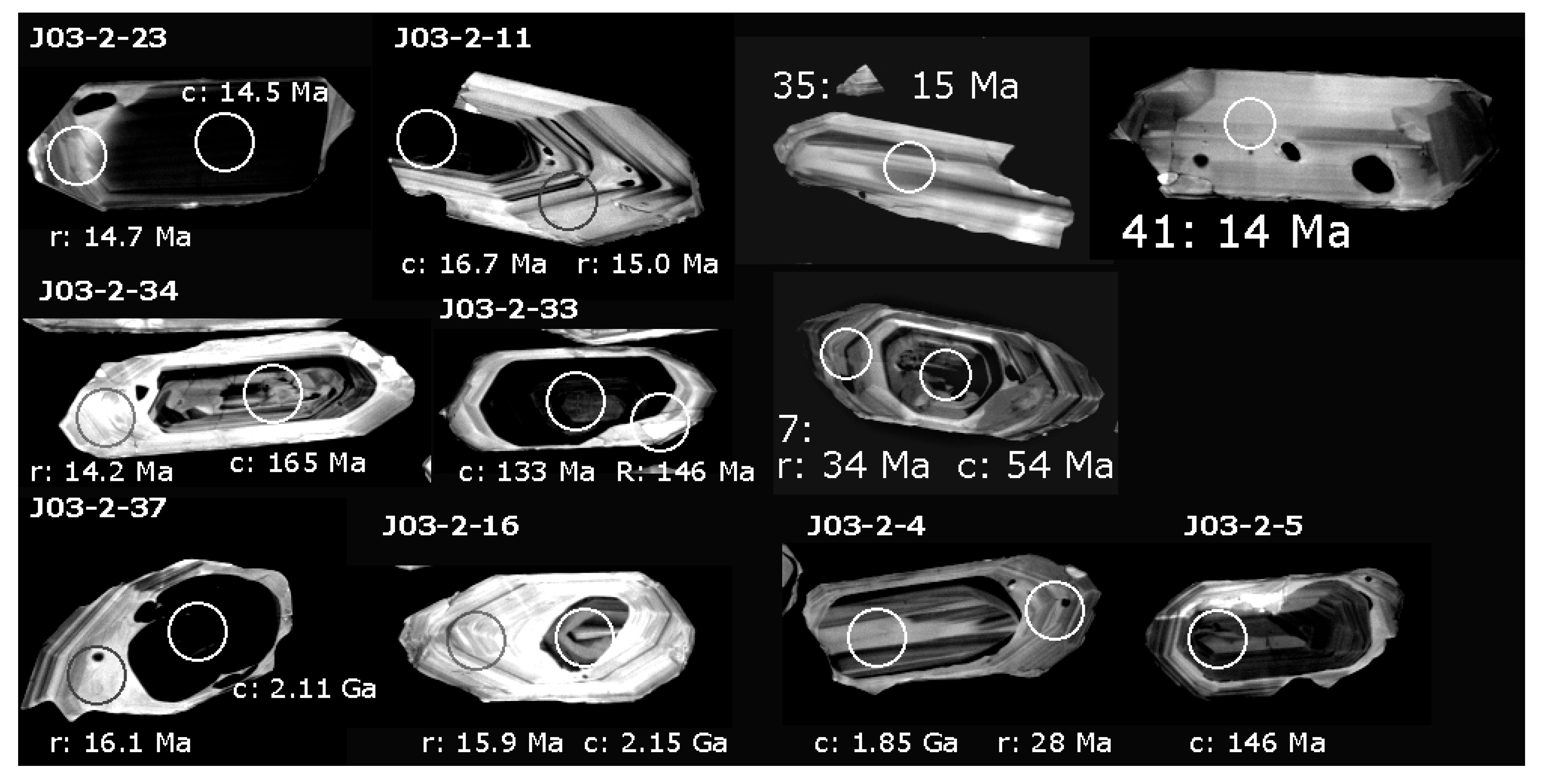Zircon Systematics of the Shionomisaki Volcano–Plutonic Complex (Kii Peninsula, Japan): A Potential Tool for the Study of the Source Region of Silicic Magmas
Abstract
1. Introduction
2. Geological Setting and Samples
3. Analytical Procedures
4. Results
5. Discussion
6. Conclusions
7. Outlook
Supplementary Materials
Author Contributions
Funding
Data Availability Statement
Acknowledgments
Conflicts of Interest
References
- Tomoaki, S.; Shinjoe, H. K–Ar Ages of the Ohmine Granitic Rocks, South-West Japan. Island Arc 2003, 12, 335–347. [Google Scholar]
- Ken, S. Contemporaneity of Tertiary Granites in the Outer Zone of Southwest Japan. Chishitsu Chosajo Geppo 1978, 29, 551–554. [Google Scholar]
- Shinjoe, H.; Orihashi, Y.; Anma, R. U–Pb Ages of Miocene near-Trench Granitic Rocks of the Southwest Japan Arc: Implications for Magmatism Related to Hot Subduction. Geol. Mag. 2021, 158, 47–71. [Google Scholar] [CrossRef]
- Yasuyuki, M. Morb-Like Tholeiites Formed within the Miocene Forearc Basin, Southwest Japan. Lithos 1985, 18, 23–34. [Google Scholar]
- Stein, G.; Charvet, J.; Lapierre, H.; Fabbri, O. Geodynamic Setting of Volcano-Plutonic Rocks in So-Called “Paleo-Accretionary Prisms”: Fore-Arc Activity or Post-Collisional Magmatism? The Shimanto Belt as a Case Study. Lithos 1994, 33, 85–107. [Google Scholar] [CrossRef]
- Shinjoe, H. Origin of the Granodiorite in the Forearc Region of Southwest Japan: Melting of the Shimanto Accretionary Prism. Chem. Geol. 1997, 134, 237–255. [Google Scholar] [CrossRef]
- Charvet, J. Late Paleozoic–Mesozoic Tectonic Evolution of Sw Japan: A Review—Reappraisal of the Accretionary Orogeny and Revalidation of the Collisional Model. J. Asian Earth Sci. 2013, 72, 88–101. [Google Scholar] [CrossRef]
- Bea, F.; Morales, I.; Molina, J.F.; Montero, P.; Cambeses, A. Zircon Stability Grids in Crustal Partial Melts: Implications for Zircon Inheritance. Contrib. Miner. Pet. 2021, 176, 18. [Google Scholar] [CrossRef]
- Olierook, H.K.H.; Kirkland, C.L.; Szilas, K.; Hollis, J.A.; Gardiner, N.J.; Steenfelt, A.; Jiang, Q.; Yakymchuk, C.; Evans, N.J.; McDonald, B.J. Differentiating between Inherited and Autocrystic Zircon in Granitoids. J. Pet. 2020, 61, egaa081. [Google Scholar] [CrossRef]
- Pidgeon, R.T.; Compston, W. A Shrimp Ion Microprobe Study of Inherited and Magmatic Zircons from Four Scottish Caledonian Granites. Earth Environ. Sci. Trans. R. Soc. Edinb. 1992, 83, 473–483. [Google Scholar]
- Miyake, Y. Geology and Petrology of the Shionomisaki Igneous Complex, Wakayama Prefecture, Japan. J. Geol. Soc. Jpn 1981, 87, 383–403. [Google Scholar] [CrossRef]
- Hisatomi, K.; Miyake, Y. Upheaval Movement and Igneous Activity in the Shionomisaki Area, Kii Peninsula, Southwest Japan. Chishitsugaku Zasshi J. Geol. Soc. Jpn. 1981, 87, 629–639. [Google Scholar] [CrossRef]
- Kishu Shimanto Research Group. Geologic Age of the Basal Part of the Kumano Group Determined by Radiolarian Fossils—The Study of the Shimanto Terrain in the Kii Peninsular, Southwest Japan (Part 14). Earth Sci. (Chikyu Kagaku) 2008, 62, 57–61. (In Japanese) [Google Scholar]
- Hiroyuki, H.; Iwano, H.; Danhara, T.; Yoshida, T. Fission-Track Dating of the Shionomisaki Igneous Complex, Kii Peninsula, Japan. J. Geol. Soc. Jpn. 2003, 109, 139–150. [Google Scholar]
- Shinjoe, H.; Orihashi, Y.; Iwano, H.; Danhara, T. Zircon U-Pb Ages of the Shionomisaki Igneous Complex, Southern Kii Peninsula. Fission Track Newslett. 2011, 24, 50–51. [Google Scholar]
- Taira, A. The Shimanto Belt in Shikoku, Japan.-Evolution of Cretaceous to Miocene Accretionary Prism. Mod. Geol. 1988, 12, 5–46. [Google Scholar]
- Tatsumi, Y.; Ishizaka, K. Origin of high-magnesian andesites in the Setouchi volcanic belt, southwest Japan, I. Petrographical and chemical characteristics. Earth Planet. Sci. Lett. 1982, 60, 293–304. [Google Scholar] [CrossRef]
- Hatenashi Research Group. Geology of the Otonashigawa Accretionary Sequence: Paleogene to Lower Eocene Accretionary Prism. In New Perspective on the Study of the Cretaceous to Neogene Shimanto Accretionary Prism in the Kii Peninsula, Southwest Japan; Shimanto Research Group Kishu, Ed.; Association for the Geological Collaboration in Japan: Tokyo, Japan, 2012; pp. 61–69. (In Japanese) [Google Scholar]
- Jackson, S.E.; Pearson, N.J.; Griffin, W.L.; Belousova, E.A. The Application of Laser Ablation-Inductively Coupled Plasma-Mass Spectrometry to in Situ U–Pb Zircon Geochronology. Chem. Geol. 2004, 211, 47–69. [Google Scholar] [CrossRef]
- Jirí, S.; Kosler, J.; Condon, D.J.; Crowley, J.L.; Gerdes, A.; Hanchar, J.M.; Horstwood, M.S.A.; Morris, G.A.; Nasdala, L.; Norberg, N.; et al. Plesovice Zircon—A New Natural Reference Material for U-Pb and Hf Isotopic Microanalysis. Chem. Geol. 2008, 249, 1–35. [Google Scholar]
- Wiedenbeck, M.A.P.C.; Alle, P.; Corfu, F.; Griffin, W.L.; Meier, M.; Oberli, F.; von Quadt, A.; Roddick, J.C.; Spiegel, W. Three Natural Zircon Standards for U-Th-Pb, Lu-Hf, Trace Element and Ree Analyses. Geostand. Newsl. 1995, 19, 1–23. [Google Scholar] [CrossRef]
- Andersen, T. Correction of Common Lead in U-Pb Analyses That Do Not Report 204pb. Chem. Geol. 2002, 192, 59–79. [Google Scholar] [CrossRef]
- Ludwig, K.R. Isoplot V. 3.0: A Geochronological Toolkit for Microsoft Excel; Berkeley Geochronology Center: Berkeley, CA, USA, 2003; Volume 4. [Google Scholar]
- Chiu, H.-Y.; Chung, S.-L.; Wu, F.-Y.; Liu, D.; Liang, Y.-H.; Lin, I.-J.; Iizuka, Y.; Xie, L.-W.; Wang, Y.; Chu, M.-F. Zircon U–Pb and Hf Isotopic Constraints from Eastern Transhimalayan Batholiths on the Precollisional Magmatic and Tectonic Evolution in Southern Tibet. Tectonophysics 2009, 477, 3–19. [Google Scholar] [CrossRef]
- Shao, W.-Y.; Chung, S.-L.; Chen, W.-S. Zircon U-Pb Age Determination of Volcanic Eruptions in Lutao and Lanyu in the Northern Luzon Magmatic Arc. Terr. Atmos. Ocean. Sci. 2014, 25, 149. [Google Scholar] [CrossRef]
- Knittel, U.; Walia, M.; Suzuki, S.; Lee, Y.-H.; Takesue, N.; Lee, H.-Y. U-Pb Ages and Hf Isotope Composition of Zircon from the Shimanto Accretionary Complex: Evidence for Heterogeneous Sources. Geochem. J. 2020, 54, 277–288. [Google Scholar] [CrossRef]
- Woodhead, J.D.; Hergt, J.M. A Preliminary Appraisal of Seven Natural Zircon Reference Materials for In Situ Hf Isotope Determination. Geostand. Geoanal. Res. 2005, 29, 183–195. [Google Scholar] [CrossRef]
- Scherer, E.; Münker, C.; Mezger, K. Calibration of the Lutetium-Hafnium Clock. Science 2001, 293, 683–687. [Google Scholar] [CrossRef] [PubMed]
- Blichert-Toft, J.; Albarède, F. The Lu-Hf Isotope Geochemistry of Chondrites and the Evolution of the Mantle-Crust System. Earth Planet. Sci. Lett. 1997, 148, 243–258. [Google Scholar] [CrossRef]
- Orihashi, Y.; Iwano, H.; Hirata, T.; Danhara, T.; Shinjoe, H. U-Pb Ages and Trace Element Compositions of Reddish, Colorless, and Detrital Zircons in the Kumano Acidic Rocks in the Outer Zone of Southwest Japan and Origin of the Host Magma. J. Geol. Soc. Jpn. 2007, 113, 366–383. [Google Scholar] [CrossRef]
- Terakado, Y.; Shimizu, H.; Masuda, A. Nd and Sr Isotopic Variations in Acidic Rocks Formed under a Peculiar Tectonic Environment in Miocene Southwest Japan. Contrib. Miner. Pet. 1988, 99, 1–10. [Google Scholar] [CrossRef]
- Ishihara, S.; Matsuhisa, Y. Oxygen Isotopic Constraints on the Geneses of the Miocene Outer Zone Granitoids in Japan. Lithos 1999, 46, 523–534. [Google Scholar] [CrossRef]
- Jahn, B.-M. Accretionary Orogen and Evolution of the Japanese Islands: Implications from a Sr-Nd Isotopic Study of the Phanerozoic Granitoids from Sw Japan. Am. J. Sci. 2010, 310, 1210–1249. [Google Scholar] [CrossRef]
- Shao, W.-Y.; Chung, S.-L.; Chen, W.-S.; Lee, H.-Y.; Xie, L.-W. Old Continental Zircons from a Young Oceanic Arc, Eastern Taiwan: Implications for Luzon Subduction Initiation and Asian Accretionary Orogeny. Geology 2015, 43, 479–482. [Google Scholar] [CrossRef]
- Xu, X.; O’reilly, S.Y.; Griffin, W.; Wang, X.; Pearson, N.; He, Z. The Crust of Cathaysia: Age, Assembly and Reworking of Two Terranes. Precambrian Res. 2007, 158, 51–78. [Google Scholar] [CrossRef]
- Xu, Y.; Wang, C.Y.; Zhao, T. Using Detrital Zircons from River Sands to Constrain Major Tectono-Thermal Events of the Cathaysia Block, Se China. J. Asian Earth Sci. 2016, 124, 1–13. [Google Scholar] [CrossRef]
- Kazuya, I.; Iwamori, H.; Orihashi, Y.; Park, T.; Jwa, Y.-J.; Kwon, S.-T.; Danhara, T.; Iwano, H. Tectonic Reconstruction of Batholith Formation Based on the Spatiotemporal Distribution of C Retaceous–P Aleogene Granitic Rocks in Southwestern Japan. Island Arc 2015, 24, 205–220. [Google Scholar]
- Takagi, T.; Kagami, H. Rb-Sr Isochron Ages and Initial Sr Isotope Ratios of the Ukan Granodiorite and Kayo Granite, Central Okayama Prefecture, Southwest Japan. Bull. Geol. Surv. Jpn. 1995, 46, 219–224. [Google Scholar]
- Kagami, H.; Honma, H.; Shirahase, T.; Nureki, T. Rb-Sr Whole Rock Isochron Ages of Granites from Northern Shikoku and Okayama, Southwest Japan: Implications for the Migration of the Late Cretaceous to Paleogene Igneous Activity in Space and Time. Geochem. J. 1988, 22, 69–79. [Google Scholar] [CrossRef][Green Version]
- Raimbourg, H.; Famin, V.; Palazzin, G.; Yamaguchi, A.; Augier, R. Tertiary evolution of the Shimanto belt (Japan): A large-scale collision in Early Miocene. Tectonics 2017, 36, 1317–1337. [Google Scholar] [CrossRef]
- Ayako, N.; Takahashi, N.; Park, J.-O.; Miura, S.; Kodaira, S.; Kaneda, Y.; Hirata, N.; Iwasaki, T.; Nakamura, M. Crustal Structure across the Coseismic Rupture Zone of the 1944 Tonankai Earthquake, the Central Nankai Trough Seismogenic Zone. J. Geophys. Res. Solid Earth 2002, 107, EPM 2-1–EPM 2-21. [Google Scholar]
- Kodaira, S.; Takahashi, N.; Park, J.; Mochizuki, K.; Shinohara, M.; Kimura, S. Western Nankai Trough Seismogenic Zone: Results from a Wide-Angle Ocean Bottom Seismic Survey. J. Geophys. Res. 2000, 105, 5887–5905. [Google Scholar] [CrossRef]
- Tokiwa, T.; Shimura, Y.; Takeuchi, M.; Mori, H. Use of Detrital Zircon U–Pb Ages to Assess the Timing of Deposition of Cretaceous Trench-Fill Deposits in the Active Continental Arc Along the East Asian Margin. J. Asian Earth Sci. 2021, 207, 104657. [Google Scholar] [CrossRef]
- Shimura, Y.; Takeuchi, M.; Tokiwa, T.; Ota, A. Detrital Zircon U-Pb Ages of the Cretaceous Unokawa Complex in the Shimanto Belt on the Central Kii Peninsula, SW Japan. J. Geol. Soc. Jpn. 2020, 126, 223–230. [Google Scholar] [CrossRef]
- Akari, O.; Takeuchi, M.; Bayart, N.; Yamamoto, K. Detrital Zircon U-Pb Ages from the Cretaceous Accretionary Complexes in the Takaharagawa Area, Central Kii Peninsula. J. Geol. Soc. Jpn. 2019, 125, 329–347. [Google Scholar]








Disclaimer/Publisher’s Note: The statements, opinions and data contained in all publications are solely those of the individual author(s) and contributor(s) and not of MDPI and/or the editor(s). MDPI and/or the editor(s) disclaim responsibility for any injury to people or property resulting from any ideas, methods, instructions or products referred to in the content. |
© 2025 by the authors. Licensee MDPI, Basel, Switzerland. This article is an open access article distributed under the terms and conditions of the Creative Commons Attribution (CC BY) license (https://creativecommons.org/licenses/by/4.0/).
Share and Cite
Knittel, U.; Walia, M.; Suzuki, S. Zircon Systematics of the Shionomisaki Volcano–Plutonic Complex (Kii Peninsula, Japan): A Potential Tool for the Study of the Source Region of Silicic Magmas. Minerals 2025, 15, 537. https://doi.org/10.3390/min15050537
Knittel U, Walia M, Suzuki S. Zircon Systematics of the Shionomisaki Volcano–Plutonic Complex (Kii Peninsula, Japan): A Potential Tool for the Study of the Source Region of Silicic Magmas. Minerals. 2025; 15(5):537. https://doi.org/10.3390/min15050537
Chicago/Turabian StyleKnittel, Ulrich, Monika Walia, and Shigeyuki Suzuki. 2025. "Zircon Systematics of the Shionomisaki Volcano–Plutonic Complex (Kii Peninsula, Japan): A Potential Tool for the Study of the Source Region of Silicic Magmas" Minerals 15, no. 5: 537. https://doi.org/10.3390/min15050537
APA StyleKnittel, U., Walia, M., & Suzuki, S. (2025). Zircon Systematics of the Shionomisaki Volcano–Plutonic Complex (Kii Peninsula, Japan): A Potential Tool for the Study of the Source Region of Silicic Magmas. Minerals, 15(5), 537. https://doi.org/10.3390/min15050537





